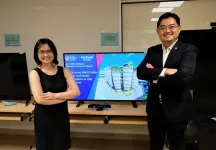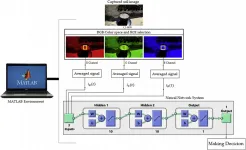(Press-News.org) CORVALLIS, Ore. - Oregon State University researchers analyzed more than 17,000 public comments focused on orca conservation in the state of Washington and found that the most common emotional sentiments were trust, anticipation and fear.
The recently published findings have important implications because they provide conservation managers a way to convert a large volume of information to a manageable amount that can help them understand why people might support or reject management actions, the researchers said.
"Emotions are intertwined in our decision-making, often playing a substantive role in public evaluations of conservation policies," said Kelly Biedenweg, an author of the study and an assistant professor at Oregon State who studies psychology in the field of conservation.
"In this context, because we had such a high combination of trust and fear and sadness, that actually is the perfect combination for implementing more conservation-based strategies because in that emotional state people are more willing to take protective actions. Whereas if people were angry, that would be bad time to implement those protective conservation strategies."
Orcas have long captured human attention for their complex behaviors and social structure. They are also an icon of the Pacific Northwest, where they are depicted in Indigenous art, featured on license plates and a driver of tourism.
Since 1996, Southern Resident orcas, the population that resides in Pacific Northwest waters, have experienced steady decline and were listed as endangered in 2005, the researchers say in the study published in the journal Conservation Science and Practice. The most critical issues to their recovery are pollution, vessel disturbance and prey availability.
The decline of orcas spurred Washington governor Jay Inslee to create a task force in 2018 to develop recommendations for orca recovery. From July 2018 through May 2019, the governor's office received more than 17,000 public comments regarding orca conservation. The large volume of public comments was in part due to several high profile orca deaths in that region during that time, including a newborn calf that died and was carried by its mother for 17 days.
The Oregon State study, led by Hailey Kehoe-Thommen, an undergraduate Honors College student who has since graduated, used an emotion lexicon that categorizes 14,000 words into eight basic emotions: joy, trust, fear, surprise, sadness, anticipation, anger and disgust.
The researchers worked with a separate team at the Center for Applied Systems & Software at Oregon State to develop a computer program that merged that lexicon with the words from the 17,000 public comments the orca task force received.
The computer program found words associated with trust in 22% of the comments, the most common of any of the eight emotion categories. Findings in the remaining categories were as follows: anticipation (18%), fear (15%), joy (11%), sadness (11%), surprise (8%), anger (8%) and disgust (7%).
Trust was most associated with words such as save, food and governor; anticipation with time, immediately and plan; fear with watching, remove and endangered; sadness with remove, problem and death; surprise with wild, good and death; anger with remove, death and money; and disgust with pollution, creatures and death.
The fact that "trust" was the most common category leads the researchers to believe that respondents have strong faith that if particular actions are taken the orcas can be saved. Furthermore, the fact that one of the most frequently used words in the trust category was "governor" suggests that respondents have some level of recognition and acceptance of this person's power to resolve the situation.
This type of finding could lead conservation organizations to build on the public acceptance of the governor's power and develop strategic actions and messaging that establish the governor's office as leading efforts to implement orca conservation, the Oregon State researchers conclude.
While the orca task force in Washington has already issued a report and recommendations, this type of analysis could be valuable in other conservation situations where there is a large volume of public comments, Biedenweg said.
"Teasing apart specific emotions to all of these issues is going to help us have a much more nuanced vision of why people are reacting in certain ways and how we might incorporate those reactions into policy," she said.
INFORMATION:
Biedenweg and Kehoe-Thommen were joined by co-author Karin Swarbrick, a master's student with Ecampus, Oregon State's online education provider, who also works in Biedenweg's lab.
(Portland - March 15) Results of a clinical study conducted by researchers in Manaus, Brazil, show that the Gazelle® Malaria test outperformed Rapid Diagnostic Tests (RDTs) and was nearly as accurate as more expensive and time-consuming expert microscopy in detecting Plasmodium vivax (P. vivax) malaria. The data was published Friday, March 12 in the Malaria Journal.
The double-blind study was based on 300 participants who sought care from Fundac?a?o de Medicina Tropical Doutor Heitor Vieira Dourado (FMT-HVD), located in Manaus, an area in the Western Brazilian Amazon, heavily endemic for P. vivax.
"Because P. vivax is not adequately detected by current tests, the infection is frequently missed, and patients don't receive essential treatment," said ...
Copper nanomaterials with a cubic shape so perfect that they form neatly aligned stacks when brought together have been created by researchers at KAUST. The cuboid copper nanoclusters, developed by rational design, are a new member of an exotic nanomaterial family that has shown many promising properties but has remained very hard to make.
"Copper nanomaterials are a class of materials that exhibit useful properties for the fields of photoluminescence and catalysis," says Ren-Wu Huang, a postdoc in Osman Bakr's lab, who led the research. There is great interest in synthesizing new copper nanomaterials to understand how their structure influences their function.
Copper nanoclusters, which are of an atomically precise structure, are among the few copper nanomaterials that ...
An interdisciplinary, multinational research team presents a new class of chemical compounds that can be reversibly oxidized and reduced. The compounds known as 'pyrazinacenes' are simple, stable compounds that consist of a series of connected nitrogen-containing carbon rings. They are suitable for applications in electrochemistry or synthesis, as the researchers describe in the science journal Communications Chemistry.
Redox reactions play an important role in our everyday life. In these reactions, one compound releases electrons and is oxidized, while another accepts ...
A discovery by University of Queensland pain researchers may allow some future cancer patients, including children with leukaemia, to avoid their chemotherapy's worst and most debilitating side effects.
Professor Irina Vetter and Dr Hana Starobova thought "turning off" the inflammation that is one of the body's natural reactions to the chemotherapy drug vincristine might reduce its accompanying pain and unpleasant symptoms.
"We found the anti-inflammatory drug anakinra substantially reduced the awful nerve symptoms for which vincristine chemotherapy is known," Professor ...
A study by a research team from Nanyang Technological University, Singapore (NTU Singapore) and China's first digital-only bank WeBank has found that security, service quality and system quality are the most important factors for customers who use mobile banking.
Two in five respondents (40%) said that the security they felt while carrying out transactions on mobile applications was their most important consideration.
This was followed by the level of service quality (25%), which referred to whether the banking applications could fulfil users' needs, such as carrying out transactions and easy access to credit card services.
System quality, which considers the performance of the application, including ...
Researchers at UniSA have developed a cost-effective new technique to monitor soil moisture using a standard digital camera and machine learning technology.
The United Nations predicts that by 2050 many areas of the planet may not have enough fresh water to meet the demands of agriculture if we continue our current patterns of use.
One solution to this global dilemma is the development of more efficient irrigation, central to which is precision monitoring of soil moisture, allowing sensors to guide 'smart' irrigation systems to ensure water is applied at the optimum time and rate.
Current methods for sensing soil moisture are problematic - buried sensors are susceptible to ...
Dr Daniel Montesinos is a Senior Research Fellow at the Australian Tropical Herbarium, at James Cook University in Cairns. He is studying weeds to better understand (among other things) how they might respond to climate change.
He said most invasive plants are characterised by their rapid pace when it comes to taking up nutrients, growing, and reproducing - and they're even faster in the regions they invade.
"New experiments comparing populations from distant regions show a clear trend for already-fast invasive plants to rapidly adapt even faster traits in their non-native regions," Dr Montesinos said.
This is further pronounced in the tropics and sub-tropics.
"Even though invasives' growth rates are already among the highest for plants, when they invade new territory ...
A new concept of on-demand drug delivery system has emerged in which the drugs are automatically released from in vivo medical devices simply by shining light on the skin.
A research team led by Professor Sei Kwang Hahn of the Department of Materials Science and Engineering and Professor Kilwon Cho of the Department of Chemical Engineering at POSTECH have together developed an on-demand drug delivery system (DDS) using an organic photovoltaic cell coated with upconversion nanoparticles. This newly developed DDS allows nanoparticles to convert skin-penetrating near-infrared (NIR) light into visible light so that drug release can be controlled in medical ...
An international team of researchers, affiliated with UNIST has unveiled a novel technology that could improve the learning ability of artificial neural networks (ANNs).
Professor Hongsik Jeong and his research team in the Department of Materials Science and Engineering at UNIST, in collaboration with researchers from Tsinghua University in China, proposed a new learning method to improve the learning ability of ANN chips by challenging its instability.
Artificial neural network chips are capable of mimicking the structural, functional and biological features of human neural networks, and thus have been considered the technology of the future. In this study, the research team demonstrated the effectiveness of the proposed learning method ...
A chromatin-regulating enzyme has been shown by in-depth interdisciplinary investigations to be a key driver of a common type of lung cancer. Drugs that target the enzyme could improve treatment and survival rates for this particular cancer.
"Squamous cell carcinoma represents nearly one third of all lung cancers in humans," says KAUST structural biologist Lukasz Jaremko, who led the research along with colleagues at Stanford University and The University of Texas MD Anderson Cancer Center, U.S. "Our joint structural and dynamics investigations, including enzymatic activity studies, genetic analyses, and mouse model and human cell results, ...





